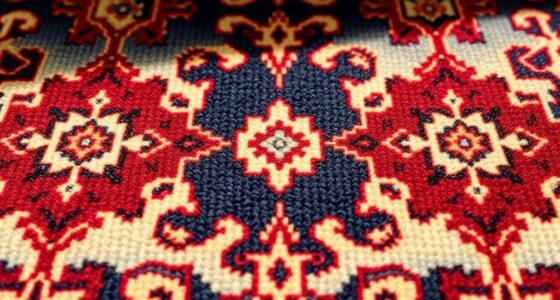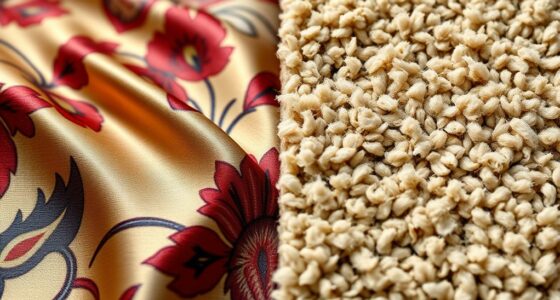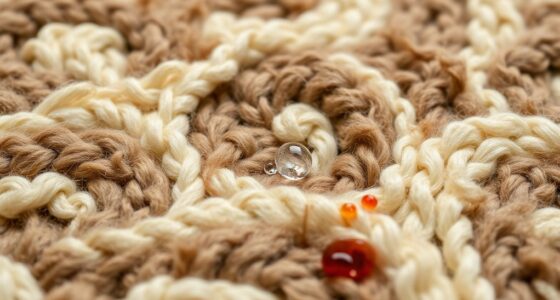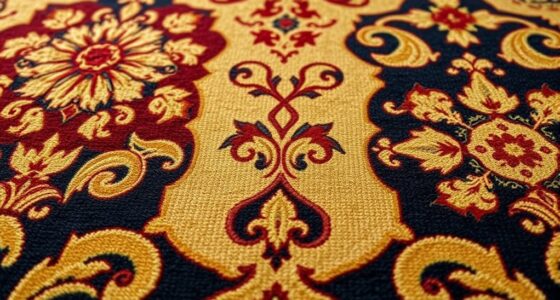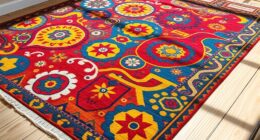You prefer untrimmed fringes because they keep the item’s original craftsmanship, cultural significance, and authenticity intact. These fringes showcase traditional techniques, symbolism, and the item’s vintage age, making them more unique and valuable. They also give a textured, natural look that highlights the history and character of the piece. By keeping fringing untouched, you’ll preserve its cultural stories and genuine beauty—there’s more to discover about why collectors treasure these features.
Key Takeaways
- Untrimmed fringes preserve the authenticity and original craftsmanship of vintage textiles.
- They serve as indicators of age, wear, and genuine handmade techniques.
- The natural, unaltered edges enhance visual appeal and highlight unique textures.
- Fringes carry cultural and symbolic significance, connecting collectors to heritage and tradition.
- Maintaining untrimmed fringes supports the item’s historical integrity and collectible value.
Preservation of Authenticity and Original Craftsmanship

Because collectors value the true essence of craftsmanship, they often prefer untrimmed fringes that showcase the piece’s original details. Untrimmed fringes highlight material durability, revealing how well the piece was constructed and the quality of the fibers used. This authenticity guarantees that the craftsmanship remains intact, preserving the item’s historical and artistic integrity. Fringe styling plays a vital role here, as the natural state of the fringes reflects the artist’s original intent, free from modern alterations. By keeping the fringes untrimmed, you allow the piece’s true character to shine through, maintaining its value and connection to traditional techniques. Additionally, Glycolic Acid exfoliation can be likened to the preservation of craftsmanship, as both processes emphasize maintaining authenticity and enhancing natural qualities. Recognizing traditional techniques emphasizes the importance of preserving original methods used in creating handcrafted items, which further supports the value of untrimmed fringes. Understanding material preservation helps collectors appreciate the durability and longevity of each piece, reinforcing its historical significance. Moreover, an awareness of conservation methods can guide collectors in maintaining the integrity of their items over time. Ultimately, untrimmed fringes serve as a testament to the skill and authenticity behind each handcrafted item.
Cultural Significance and Traditional Crafting Techniques

Traditional crafting techniques carry deep cultural significance, often embodying the history, beliefs, and identity of a community. When you appreciate untrimmed fringes, you honor centuries of craftsmanship passed down through generations. These techniques reflect a community’s unique story, resisting fleeting fashion trends and modern manufacturing’s mass production. Untrimmed fringes preserve the integrity of traditional methods, showcasing hand-woven or hand-stitched details that highlight authenticity. They serve as symbols of cultural pride and craftsmanship resilience. To better understand, consider this table:
| Technique | Cultural Significance | Impact on Fashion Trends |
|---|---|---|
| Hand-weaving | Preserves heritage | Influences contemporary design |
| Natural dyes | Reflects local environment | Adds authenticity to trends |
| Fringe formation | Symbol of identity | Contrasts mass-produced styles |
| Embroidery | Cultural storytelling | Maintains traditional aesthetics |
Furthermore, cultural preservation ensures that these traditional methods continue to thrive amidst modern influences. Engaging in the appreciation of untrimmed fringes also fosters a deeper respect for the craftsmanship and artistry involved in traditional textile arts.
Visual Appeal and Unique Aesthetic Qualities

Untrimmed fringes possess a distinctive visual appeal that immediately captures your attention with their dynamic movement and textured complexity. This aesthetic creates a sense of lively energy, making each piece stand out in a collection. As fashion trends evolve, many collectors appreciate the raw, unpolished look that untrimmed fringes offer, reflecting authenticity and craftsmanship. Their unique, natural flow adds depth and character, making them more visually engaging than trimmed alternatives. Market demand for these fringes remains strong because collectors seek items that showcase originality and a sense of individuality. The untrimmed fringes’ aesthetic quality lies in their imperfect beauty, giving each piece an authentic and compelling charm that appeals to those valuing visual distinctiveness in their collections. Additionally, awareness of Legislative changes related to materials can influence the desirability and legality of certain fringed items in collections. Recognizing the importance of sustainable sourcing can also enhance a collector’s appreciation for ethically produced pieces. Moreover, understanding the cultural significance behind fringe designs can deepen collectors’ appreciation for their historical and symbolic value. Furthermore, the craftsmanship involved in creating untrimmed fringes highlights the skill and tradition behind their production, adding to their collectible appeal. A deeper understanding of material regulations ensures collectors are informed about the legal considerations when acquiring such items.
Indicator of Vintage and Age Authenticity

Untrimmed fringes often serve as a key indicator of vintage and age authenticity, revealing subtle signs of wear and craftsmanship that newer pieces lack. Unlike modern fashion, which favors clean, uniform finishes, authentic older items show irregularities and natural aging in their fringes. Mass production tends to produce consistent, perfectly trimmed fringes, making untrimmed edges a telltale sign of handcraftsmanship and age. When you examine fringes closely, you can spot fraying, uneven lengths, and signs of use that confirm the piece’s vintage origin. These details help distinguish genuine antiques from reproductions or modern replicas designed to look old. Additionally, the algorithm promoting content on platforms like TikTok has made vintage styles more visible, increasing interest in authentic details such as untrimmed fringes. Recognizing craftsmanship details like irregular fringes is essential for verifying a piece’s true vintage status. Furthermore, understanding how market trends influence the perception of authenticity can help collectors make more informed decisions. Moreover, observing how wear and patina develop over time can provide further clues about a piece’s age and authenticity. A careful examination of material quality can also reveal differences between genuine vintage textiles and modern imitations.
Symbolic Connection to Heritage and History

Because they carry unique designs and motifs, fringes often serve as powerful symbols of cultural heritage and history. Many collectors see untrimmed fringes as preserving a direct link to the past, embodying traditions that have endured over generations. These fringes tell stories through their craftsmanship, patterns, and symbolic meanings, making them more than just decorative elements. While fashion trends shift toward sleek and minimal styles, modern adaptations of fringed items retain their historical significance. They act as a visual reminder of cultural identities and social histories, allowing you to connect with a tradition that’s rooted deep in history. Untrimmed fringes, thus serve as timeless markers of heritage, making them especially meaningful for collectors who value history’s ongoing influence on fashion. Additionally, the craftsmanship involved in creating these fringes reflects traditional techniques passed down through generations, further emphasizing their cultural importance. Recognizing the symbolic significance of fringes enhances appreciation for their role in expressing social and cultural narratives across different communities.
Desire for Untouched and Natural Textural Features

You value the authenticity and rawness that untouched fringes offer, seeing them as a true reflection of their natural state. The organic textures draw your eye and connect you to the piece’s genuine origins. It’s this appreciation for raw, unaltered details that makes untrimmed fringes so appealing.
Emphasis on Authenticity and Rawness
Many collectors value pieces that showcase their natural state, seeking authenticity and rawness over perfection. They prefer untrimmed fringes because these retain genuine textures and imperfections that reflect true craftsmanship. In a world dominated by modern design and mass production, such pieces stand out as authentic, unfiltered expressions of creativity. You appreciate the rawness because it tells a story—each uneven edge and irregular fringe highlights the handmade quality that mass-produced items often lack. This emphasis on authenticity allows you to connect with the piece on a deeper level, valuing its untouched appearance over polished, manufactured perfection. Ultimately, you see untrimmed fringes as a celebration of natural beauty and genuine craftsmanship, resisting the sanitized excess of modern trends.
Appreciation for Organic Textural Details
Organic textural details captivate collectors who seek authenticity in every piece. You value the natural imperfections, feeling they reveal the material’s durability and history. Untrimmed fringes showcase the raw edges, emphasizing their symbolic meaning—fragility intertwined with resilience. These textures add depth, making each item unique and tactile. You appreciate that untouched fringes preserve the original craftsmanship, reflecting a genuine connection to tradition. The irregularities highlight the fringe symbolism of individuality and strength.
| Material Durability | Fringe Symbolism |
|---|---|
| Shows age gracefully | Represents resilience |
| Reveals authentic wear | Embodies cultural significance |
| Indicates quality over time | Signifies untouched authenticity |
The Role of Untrimmed Fringes in Collectible Value

Untrimmed fringes remarkably enhance the collectible value of certain textiles and garments by preserving their authenticity and historical integrity. They serve as proof of original craftsmanship, making each piece unique. Fringe manipulation, whether intentional or accidental, tells a story of how the item was created and used over time. Modern modifications often trim or alter fringes, which can diminish a piece’s value for collectors seeking authenticity. Untrimmed fringes maintain the garment’s original design, offering insight into its cultural and historical context. For collectors, these fringes are more than decorative; they’re crucial indicators of originality. By avoiding modern modifications that trim or alter fringes, you preserve the piece’s integrity and increase its desirability and worth in the collector’s market.
Frequently Asked Questions
How Do Untrimmed Fringes Affect the Durability of Collectibles?
Untrimmed fringes can impact the durability of collectibles by exposing delicate fibers to damage and wear over time. Proper fringe preservation is essential to maintain their condition, especially since fragile fringes are more prone to fraying or tearing. As a collector, you’ll find that preferences vary; some value untrimmed fringes for authenticity, but understanding how they affect longevity helps you make informed decisions and care for your collection properly.
Are Untrimmed Fringes More Prone to Damage Over Time?
You might wonder if untrimmed fringes are more prone to damage over time. While they can be more delicate due to their loose fibers, fringe aesthetics often appeal to collector preferences for authenticity and originality. If you handle your collectibles carefully and avoid excessive friction, untrimmed fringes can maintain their integrity. Ultimately, protecting your items and understanding their material helps preserve their value, regardless of fringe style.
What Maintenance Is Required for Collectibles With Untrimmed Fringes?
For fringe preservation, you need to handle collectibles with untrimmed fringes carefully. Regular fringe cleaning is essential; gently dust and avoid harsh chemicals that could damage the fibers. Store them in a cool, dry place, and avoid excessive handling to prevent fraying. Periodic inspection helps catch any signs of wear early. With proper maintenance, your collectibles will stay vibrant and intact, showcasing their unique untrimmed fringes beautifully over time.
Do Untrimmed Fringes Influence the Item’s Market Value?
Untrimmed fringes can considerably influence an item’s market perception and aesthetic appeal. You might find that collectors see untrimmed fringes as more authentic and original, which can boost the item’s value. On the other hand, some buyers prefer a cleaner look, so it might lower the appeal for certain markets. Overall, untrimmed fringes often add character, making the piece more desirable to specific collectors.
Can Untrimmed Fringes Be Restored if Damaged?
You might believe untrimmed fringes are irreplaceable, but fringe restoration is possible with expert care. Damaged fringes often result from wear or improper handling, yet careful repair can preserve their integrity. Prevent damage by handling items gently and storing them properly. While restoring fringes can be delicate, skilled restoration can enhance longevity, ensuring your collection remains valuable and beautiful for years to come.
Conclusion
So, next time you overlook those untrimmed fringes, remember—they’re not just messy edges but a proof to authenticity, craft, and history. Ironically, what some see as flaws actually boost value, making these pieces more genuine and desirable. In a world obsessed with perfection, it’s the untouched, natural fringes that truly tell a story, proving that sometimes, imperfection isn’t a flaw but the most refined mark of artistry.


